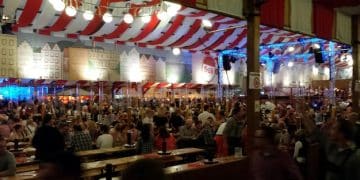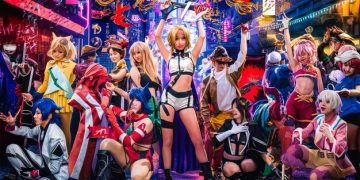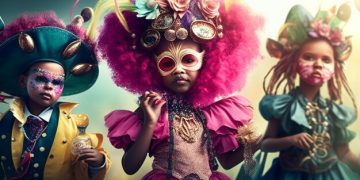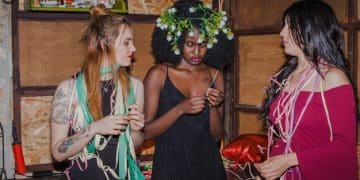Exploring the World of Cosplay: A Geek Lifestyle Deep Dive
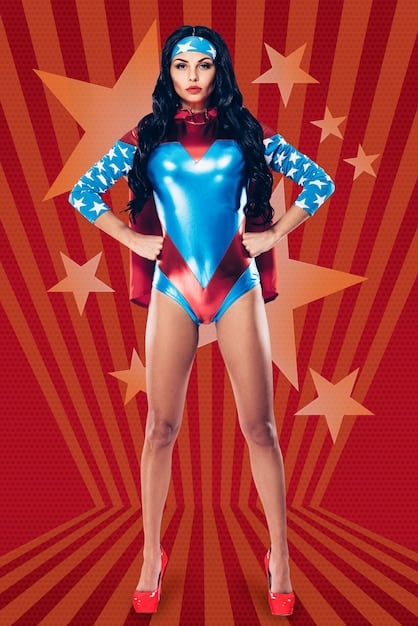
Cosplay, a portmanteau of “costume play,” embodies a vibrant subculture within the geek lifestyle where enthusiasts craft and wear elaborate costumes to embody fictional characters, celebrating creativity, skill, and community.
Dive headfirst into the captivating realm of cosplay, a cornerstone of geek culture where imagination meets craftsmanship. More than just dressing up, cosplay is an art form, a community, and a lifestyle that invites you to become your favorite characters.
What is Cosplay? Defining the Art of Costume Play
Cosplay, short for “costume play,” is the act of dressing up as characters from various forms of media, including anime, manga, video games, comic books, and movies. It’s about transforming into a beloved character, not just wearing a costume, but embodying their persona.
At its heart, cosplay is a celebration of fandom, skill, and creativity. Cosplayers invest time, effort, and often significant resources into creating accurate and impressive representations of their chosen characters.
The Difference Between Cosplay and Halloween Costumes
While both involve wearing costumes, the level of detail and commitment sets cosplay apart. Halloween costumes are often store-bought and worn for a single night. Cosplay, on the other hand, emphasizes accuracy and craftsmanship, with many cosplayers hand-making their costumes and accessories.
The Allure of Becoming Someone Else
Cosplay offers a unique opportunity to step outside of oneself and experience the world from a different perspective. It allows individuals to express their admiration for a character and connect with a wider community of like-minded fans.
- Craftsmanship: Many cosplayers create their costumes from scratch, showcasing impressive sewing, prop-making, and special effects skills.
- Performance: Bringing a character to life through accurate portrayal and acting is a core element of cosplay.
- Community: Cosplay fosters a strong sense of community, with conventions and online forums providing platforms for sharing, learning, and supporting each other.
Ultimately, cosplay is a dynamic and evolving art form that transcends simple costuming. It’s a creative outlet, a form of self-expression, and a way to connect with a community that shares a passion for fictional worlds and characters. It truly gives a deeper meaning to the geek lifestyle.
The History of Cosplay: From Science Fiction to Global Phenomenon
The roots of cosplay can be traced back to early science fiction conventions. These events provided a space for fans to gather and express their love for their favorite stories and characters through costuming.
Over time, cosplay evolved from simple homemade costumes to elaborate and meticulously crafted creations. The influence of Japanese anime and manga played a significant role in shaping the modern cosplay scene.
The Early Days of Cosplay: Convention Costumes
The first documented instance of cosplay is often attributed to Forrest J Ackerman and his partner Myrtle R. Douglas, who attended the 1939 World Science Fiction Convention dressed in futuristic costumes. This event marked the beginning of a cultural phenomenon.
The Influence of Japanese Anime and Manga
The rise of anime and manga in the late 20th century significantly impacted cosplay. Japanese fans began creating costumes based on their favorite characters, incorporating intricate details and vibrant colors. This style of cosplay gained popularity worldwide.
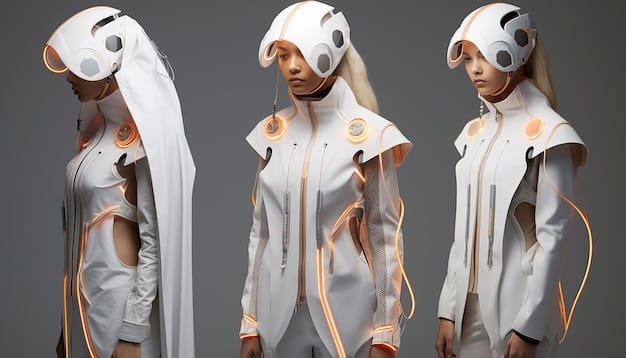
With the advent of the internet, cosplay communities flourished online. Websites and forums provided platforms for sharing tutorials, showcasing costumes, and connecting with fellow cosplayers from around the globe.
- Science Fiction Conventions: The birthplace of cosplay, where fans first began expressing their fandom through costuming.
- Anime and Manga: A major influence on the style and themes of modern cosplay.
- The Internet: Facilitated the growth of cosplay communities and the sharing of techniques and resources.
Today, cosplay is a global phenomenon enjoyed by millions of people of all ages and backgrounds. Its evolution reflects the changing landscape of fandom and the increasing accessibility of resources and materials for crafting elaborate costumes.
Essential Cosplay Skills: Crafting Your Transformation
Creating a compelling cosplay involves a diverse range of skills, from sewing and prop-making to wig styling and makeup. Mastering these skills allows you to bring your chosen character to life in a truly authentic and impressive way.
While some cosplayers specialize in a particular area, such as armor fabrication or wig styling, many strive to develop a well-rounded skillset to tackle all aspects of costume creation. Learning from tutorials, workshops, and online communities is essential for improving your cosplay skills.
Sewing and Fabric Selection
Sewing is a fundamental skill for creating the base of many costumes. Understanding different fabric types, pattern-making, and sewing techniques is crucial for achieving a well-fitting and accurate garment.
Prop-Making and Armor Fabrication
Many characters require props and armor pieces, which can be crafted from a variety of materials, including foam, plastic, and metal. Learning techniques such as sculpting, mold-making, and casting allows you to create realistic and durable props.
Wig styling is an art in itself, requiring techniques such as cutting, styling, and dyeing to achieve the perfect hair for your character. Makeup skills are equally important for transforming your appearance and enhancing your likeness to the character.
- Sewing: Essential for creating fabric-based costumes and altering existing garments.
- Prop-Making: Allows you to create realistic and durable accessories.
- Wig Styling: Transforming wigs to match the character’s hairstyle.
- Makeup: Enhancing your appearance and creating character-specific features.
Developing your cosplay skills takes time and practice, but the rewards are well worth the effort. The ability to create your own costumes and props allows you to express your creativity and bring your favorite characters to life in a truly unique way.
Cosplay Conventions: Connecting with the Community
Cosplay conventions are a central part of the cosplay experience. These events provide a space for cosplayers to showcase their creations, compete in costume contests, and connect with fellow fans.
Conventions offer a vibrant and energetic atmosphere, filled with passionate individuals who share a love for cosplay and fandom. Attending conventions is a great way to meet new friends, learn new skills, and be inspired by the creativity of others.
Showcasing Your Cosplay
Conventions provide a platform for cosplayers to display their hard work and dedication. Walking around in costume allows you to share your creation with others and receive feedback and appreciation.
Costume Contests and Competitions
Many conventions host costume contests, where cosplayers can compete for prizes and recognition based on craftsmanship, accuracy, and performance. These contests are a great way to challenge yourself and showcase your skills.
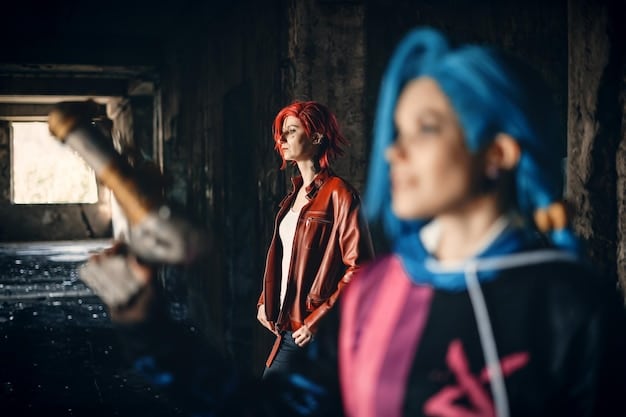
Conventions also offer a wealth of workshops and panels where you can learn new techniques and tips from experienced cosplayers. These educational sessions can help you improve your skills in areas such as sewing, prop-making, and wig styling.
- Showcasing Costumes: A chance to share your creations with a wider audience.
- Competitions: A platform to challenge yourself and gain recognition for your skills.
- Workshops and Panels: Opportunities to learn new techniques and improve your craft.
Attending cosplay conventions is an integral part of the cosplay experience. These events provide a vibrant and supportive community where you can connect with fellow fans, showcase your creations, and learn new skills.
The Growing Popularity of Cosplay: Beyond the Geek Niche
Once confined to niche gatherings, cosplay has transcended its origins and exploded into mainstream culture. With greater visibility in media and online platforms, more people than ever are embracing this creative hobby.
Cosplay’s appeal extends beyond traditional geek circles, attracting individuals from diverse backgrounds who appreciate the artistry, self-expression, and community it fosters. This growing popularity has led to increased commercialization and recognition within the entertainment industry.
Social Media and Online Communities
Platforms like Instagram, Facebook, and TikTok have played a pivotal role in amplifying cosplay’s reach. Cosplayers can easily share their work, connect with fans, and collaborate on projects, fostering a global community.
Cosplay in Mainstream Media
Cosplay has increasingly appeared in movies, television shows, and video games, showcasing its creativity and impact. This exposure has helped normalize cosplay and introduce it to a wider audience, making it more accessible and accepted.
The economic influence of cosplay is also on the rise. Costume shops, fabric suppliers, and prop-making materials are benefiting from the demand, while sponsored cosplay events and endorsements are becoming common, providing financial opportunities for talented individuals.
- Increased Visibility: Cosplay’s presence in mainstream media has broadened its appeal.
- Online Communities: Social media platforms facilitate the sharing and promotion of cosplay creations.
- Economic Impact: Cosplay-related industries are experiencing significant growth and commercialization.
Cosplay’s remarkable journey from a subculture activity to a widely recognized and celebrated art form highlights its ability to unite people, inspire creativity, and promote self-expression. It’s a trend that’s here to stay, constantly evolving and influencing the broader cultural landscape.
Cosplay Ethics and Etiquette: Respect and Responsibility
As cosplay gains popularity, it’s crucial to understand the ethical considerations and proper etiquette within the community. Respecting other cosplayers, adhering to convention rules, and promoting inclusivity are key aspects of responsible cosplay.
Ethical cosplay practices involve avoiding cultural appropriation, ensuring consent when photographing or interacting with cosplayers, and being mindful of costume choices that may be offensive or harmful. Creating a safe and welcoming environment for everyone is paramount.
Consent and Photography
Always ask for permission before taking someone’s photograph. Respect their wishes if they decline. Avoid touching or invading their personal space without prior consent. Remember, “Cosplay is not consent.”
Cultural Sensitivity
Be mindful of cultural appropriation when choosing a character. Research the character’s background and cultural significance. Avoid costumes that perpetuate harmful stereotypes or misrepresent cultural identities.
Promote inclusivity by being welcoming and supportive of cosplayers from all backgrounds, regardless of their race, gender, sexual orientation, or body type. Challenge prejudice and discrimination within the community.
- Consent is Key: Always seek permission before photographing or interacting with cosplayers.
- Cultural Sensitivity: Research and respect cultural backgrounds when choosing a character.
- Promote Inclusivity: Create a welcoming and supportive environment for all members of the community.
By adhering to ethical guidelines and practicing good etiquette, cosplayers can foster a positive and respectful community where everyone feels safe, valued, and empowered to express their creativity without fear of harm or discrimination. It’s about respecting each other and enhancing geek lifestyle.
| Key Concept | Brief Description |
|---|---|
| 🎭 Cosplay Definition | Dressing up as characters from media, embodying their personas. |
| 🧵 Essential Skills | Sewing, prop-making, wig styling, and makeup application. |
| 🤝 Convention Ethics | Respect, consent, inclusivity, and cultural sensitivity. |
| 🚀 Historical Roots | Evolved from sci-fi conventions, influenced by anime/manga. |
Frequently Asked Questions About Cosplay
▼
Cosplay is more involved; it means embodying a character from media through self-made costumes and portraying their persona accurately. Regular costumes are often store-bought and worn for less dedication.
▼
Start with online tutorials for sewing or makeup, join local cosplay groups for tips, and practice consistently. Consider attending workshops at conventions to improve specific skills.
▼
Politely ask them to delete the photo if you’re uncomfortable. If they refuse, inform convention staff. It’s essential to assert your boundaries regarding your image.
▼
Research the character’s cultural background, avoid stereotypes, and ensure your portrayal respects the culture depicted. If unsure, seek advice from people of that culture or experienced cosplayers.
▼
Include safety pins, a small sewing kit, hot glue, scissors, matching thread, and extra fasteners. These items can help fix minor costume malfunctions while at a convention.
Conclusion
Cosplay, with its blend of artistic expression, skill-based craft, community engagement, and performance, has evolved into a significant facet of the geek lifestyle. From its humble beginnings at science fiction conventions to its current status as a global phenomenon, it continues to inspire creative expression and foster connections among fans worldwide. Embracing its ethics and etiquette ensures a respectful and inclusive community for all.
